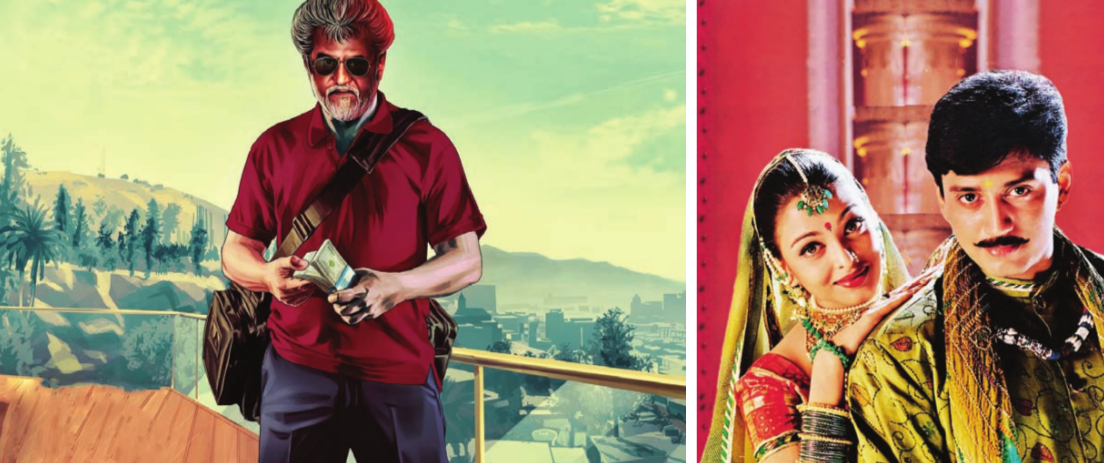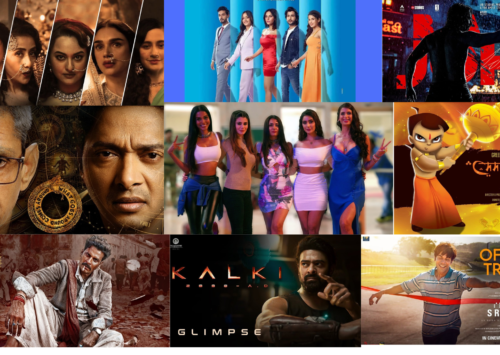South Indian Cinema
India & You
May-June 2016

South Indian Cinema, Endless Entertainment
Despite the challenges that come along with being regional cinema, two of the five film industries of south India – Telugu and Tamil cinema – worked against odds to produce a few of the most commercially successful and critically acclaimed films.
In the eyes of amateurs, Indian cinema is just a mix of an elongated love story, songs, energetic dances and surrealist actions. Bollywood has nourished an international reputation of Asian entertainer, as Hollywood did for the west. However, the neophytes forget quickly the complexity and diversity of India while speaking about the Indian cinema.
In the surfing success wave of Kollywood (Tamil cinema) and Tollywood (Telugu cinema), the two of the five South Indian cinemas, few films have marked a technological revolution. Kochadaiiyaan (2014) starring South Indian superstar Rajinikanth and Hindi film industry’s popular actress Deepika Padukone, for instance, despite failing to leave a remarkable trace was an attempt to make a breakthrough incinematography. The film also placed a foundation for Baahubali (2015), a USD 18 million production, the most expensive period film in the history of Indian cinema. Produced by a Hyderabad based company, Makuta VFX, it become the one of the top non-Hindi films to be exported out of the Asian border.
“Before these films, Tamil cinema has brought the house down with Jeans, a Tamil hit featuring Aishwarya Rai, and one of her first successes also. The movie was full of special effects and the public liked it. Before that, in 1994, Tamil movie Kadhalan shows also some feats in special effects. It is something that South Indian cinema has developed since the beginning, as many old movies were speaking about God, temples, miracles, etc.,” says Arivu Selvam, cinema critic and columnist about Tamil cinema in Cinekoothu, a Tamil magazine.
The trend today is also that of horror films with the most recent in the list being released Darling 2 (2016). The first opus, Darling (2015), a horror-comedy film directed by Sam Anton, brought three young desperate friends (interpreted by G.V Prakash Kumar, Nikki Galrani, and Bala Saravanan) to a cottage to commit suicide. Unfortunately, their plan failed as the girl is possessed by the spirit of a ghost. The participation of some supporting actors in Tamil Nadu cinema such as Rajendran and Karunas made the horror-comedy film irresistible. The success resulted in USD 4.8 million at the box office, a big deal for a small budget movie. “To make a blockbuster depends, of course, on the mindset of the people. Today, many of them are pressurised by their jobs and lifestyle so they think that if they spend INR 100 (EUR 1.32) for a ticket with their families, it should give package of emotions and complete fun. It should make everyone happy and give not only action but also romance, etc.,” explains Arivu Selvam.
Chennai, the new cinema centre
In the early 30’s Madras Presidency, today Chennai, did not have any studio. Most of the films were shot in Mumbai and Kolkata leading to the additional expense for low cost films. Progressively, Chennai became a new cinema centre, and attracted some directors from West Bengal. “During this time, public was attracted by the songs in Hindi.Over time, Tamil songs were introduced and the lyrics took predominance in Kollywood,” says Sundar Kaali, member of the editorial board of Tamil film journal, Kaatchi Pizhai,and professor in Kamaraj University of Madurai. Later, AR Rahman, broke the linguistic barrier. Recognised as the “Mozart of Madras”, the composer and song writer has won multiple awards from across the world – Academy Awards, Grammy Awards, BAFTA Award, Golden Globe to name a few, and thus giving visibility to the Tamil language.
Another delegate of Kollywood abroad, Kamal Haasan, visited the Cannes Film Festival in 2014. As a chairman of the FICCI Media and Entertainment Committee, Haasan focussed on expending the market of the Indian cinema in all its diversity. “Kamal Hassan has largely participated in the development of Tamil cinema. For instance, he was the first one to use multiple languages in his movie, Hey Ram. After Bollywood, Kollywood is the second most exported cinema, mostly due to Indian diaspora,” says Arivu Selvam.
Independent trend
Far from the media alerts, a new generation filmmaker tries to recall the soul of the independent cinema in Tamil Nadu. “With the popularity of Dravidian movement in Tamil Nadu, appeared a new political cinema in the last 1950’s to 1960’s. It started around 1947 with the growth of state political party DMK (Dravida Munnetra Kazhagam), until they reach the mainstream political parties, in 1967 and give up their demand for a separate state, the Dravida Nadu,” says Kaali.
As the socio-political movement was fighting against superstition, many mythological films were made on the subject as well as on the social issues.The novelist Jayakanthan influenced the movement. Later, in 1976, his novel Sila Nerangalil Sila Manithargal was adapted in cinema. The plot spoke about a girl’s feeling of culpability about sexuality, as well as the treatment of the society in this matter.The controversial subject brought Tamil cinema in focus in the early 1970’s.“Politically in Tamil Nadu, the 70’s marked the scission between the political parties DMK and AIADMK (All India Anna Dravida Munnetra Kazhagam) founded by the popular actor MG Ramachandran. It made all star system to collapse; new producers, new actors appeared in cinematographic environment with new proposals,” says Sundar Kaali. He adds, “Lot of people came to know about it, from the film industry, mostly from Bengal. It just started as a movement, and grabbed larger audience, already attract by Dravidian movement.” Realist films adapted from Jayakanthan novels, without songs and with a low budget – became massive hits.
Some controversial ideas were at this time laid in the theater. Director K Vijayan’s film Rudra Thandavam (1978), for instance, showed Lord Shiva appearing in the dream of a priest, asking his devotees to be more rationalist in their prayer to him.
“In 1970’s, directors were influenced by the Italian neo-realist cinema, particularly in South India. John Abraham, a Malayali directed ‘Agraharathil Kazhutai’ in 1977. It was an independent movie dealing with superstition. Many initiatives appeared at this time,” says Sundar Kaali.
Today, directors such as RP Amudhan, known for his work on caste and social discrimination in films like Shit (2003), Notes From the Crematorium (2005), and his trilogy about anti-nuclear movement in Southern India ‘Radiation’ represent some of the milestones of independent Tamil cinema.
While these are predominantly a few of the serious films on social issues, more recently Pichaikkaran (2016), a man’s struggle to find the way out of the life’s niches, and Visaranai (2015), a fight between innocent and judiciary and political institutions are some of the contemporary blockbusters conveying social issues in a casual way. The public has been receptive, even if the message fails sometimes to reach its target. Most of the movies are also supported by superstars of the industry such as Vijay, Rajinikanth and Ajith. While the female protagonist’s role may be as important as the male’s, in reality the media promotes more about actors, and the career of actresses seem to be shorter. In the same way, mostly male directors dominate Kollywood. Amongst them, a new generation of women try to make a difference such as- Soundarya Rajinikanth Ashwin (daughter of Rajinikanth), Sripriya, Lakshmy Ramakrishnan and Ambika to name a few.
After 2000 the film industry has undergone tremendous change and evolution. The Kollywood has embraced many young and new talents on various branches of film industry. Unlike Bollywood where one sees a pedigree of forerunners in industry without hassle the current trend in Kollywood allows it to be open to all talents.
Upcoming blockbusters
The upcoming films feature two superstars of the the Tamil cimema – Rajinikanth, 66, who has appeared in 158 films, facing this superstarin the multiplex would be Vijay, 41, with a history of 64 films since his childhood. Fans are expecting their new success in the respective production: Kabali and Theri.
Blazing posters and stunning style king of south, Rajinikanth’s most anticipated film Kabali is expected toreleaseon May 27 this year. Rajinikanth’s mesmerising style and elaborate posters spellbound the fans with their imagination such as that in blockbuster film Robot (2010). Kabali is directed by Pa Ranjith, produced by Kalaipuli S Thanu and has music by Santhosh Narayanan. The movie has been shot in Malasiya, Thailand and Hong Kong. The film is set to shake the box office like other Rajinikanth’s films.
Theri, officially announced as the 59th film of Vijay, is written and directed by Atlee and produced by Kallaipuli S Thanu. The film features Vijay as multiple characters with actresses Samantha and Amy Jackson in the lead roles. But the makers kept the plot a secret until its release on April 16 recently, on the eve of Tamil New year, as the success of the film was entirely built on Vijay’s personality. The film that hit 420 theatres in Tamil Nadu collected nearly INR 131 million (EUR 1.7 million) on its opening day. In the United States, it surpassed Rajinikanth’s Robot and Lingaa by grossing INR 160 million (EUR 2 million) on its first day.
Low budget but expected major hit
A new generation of actors are also driven towards the small production houses with powerful stories. “Visaranai (2015), for instance, rocked the box office recently. In his courageous effort, director Vetrimaaran, showcase the dark side of the police. Actor Dinesh played the lead role of an innocent labour, who was detained by the Andhra Pradesh state police in a framed robbery along with his friend. Another police officer from Tamil Nadu brings them back to place and as they prepare themselves for a fresh start, they are targeted by the police again. The director has shown the vulnerability of innocent against power and influence. The story harvests tears and anger towards the corruption. Crafted with care, Visaranai is a master piece by Vertimaaran.
Another film Pichaikkaran, released recently in March, performed successfully at the box office. The film that is directed by Sasi, has Vijay Antony and Santa Titus in lead roles. In the action thriller film, a millionaire is forced to live on the street out of circumstances. What made rich man to leave his luxury and how new social relations are built out of this situation? Sasi has tried to showcase the day to daysocial issues. The sound tracks made by Vijay Anthony, the actor himself, is said have supported the success of the film.









